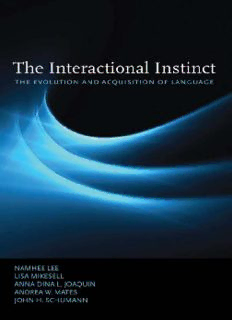Table Of ContentThe Interactional Instinct
This page intentionally left blank
The Interactional Instinct
The Evolution and Acquisition of Language
Namhee Lee
Lisa Mikesell
Anna Dina L. Joaquin
Andrea W. Mates
John H. Schumann
1
2009
3
OxfordUniversityPress,Inc.,publishesworksthatfurther
OxfordUniversity’sobjectiveofexcellence
inresearch,scholarship,andeducation.
Oxford NewYork
Auckland Cape Town DaresSalaam HongKong Karachi
KualaLumpur Madrid Melbourne MexicoCity Nairobi
NewDelhi Shanghai Taipei Toronto
Withofficesin
Argentina Austria Brazil Chile Czech Republic France Greece
Guatemala Hungary Italy Japan Poland Portugal Singapore
SouthKorea Switzerland Thailand Turkey Ukraine Vietnam
Copyright©2009byOxfordUniversityPress,Inc.
PublishedbyOxfordUniversityPress,Inc.
198MadisonAvenue,NewYork,NewYork10016
www.oup.com
OxfordisaregisteredtrademarkofOxfordUniversityPress.
Allrightsreserved.Nopartofthispublicationmaybereproduced,
storedinaretrievalsystem,ortransmitted,inanyformorbyanymeans,
electronic,mechanical,photocopying,recording,orotherwise,
withoutthepriorpermissionofOxfordUniversityPress.
LibraryofCongressCataloging-in-PublicationData
Theinteractionalinstinct:theevolutionandacquisition
oflanguage/NamheeLee...[etal.].
p. cm.
Includesbibliographicalreferences.
ISBN978-0-19-538424-6;978-0-19-538423-9(pbk.)
1. Languageacquisition. 2. Languageandlanguages—Origin.
3. Socialinteraction. I. Lee,Namhee,1961–
P118.I493 2009
4010.93—dc22 2008036807
1 3 5 7 9 8 6 4 2
PrintedintheUnitedStatesofAmerica
onacid-freepaper
Preface
This book is the product of an ongoing research program conducted by the
NeurobiologyofLanguageResearchGroup(NLRG),whichispartofthegraduate
program in applied linguistics at the University of California, Los Angeles.
Studentsinthisgrouparetrainedinlinguistics,conversationalanalysis,neuro-
biology,evolution,languageacquisition,andcomplexadaptivesystemstheory.
Each master’s degree student completes a thesis, and in the doctoral program,
studentswritetwoqualifyingpapersthatmustbejudgedbytwofacultyadvisers
to be of publishable quality; additionally, of course, the PhD students write
doctoral dissertations. The NLRG has been able to organize these academic
projectsintocoauthoredbooks.Thefirstvolumeintheseries,TheNeurobiology
ofLearning:Perspectives fromSecond LanguageAcquisition,byJohnH.Schu-
mann,ScheilaE.Crowell,NancyE.Jones,NamheeLee,SaraAnnSchuchert,and
Lee Alexandra Wood, was published in 2004. The Interactional Instinct is the
series’secondvolume.ItsfirsttwochaptersarebasedonNamheeLee’sdoctoral
dissertation,andchapters3,4,and5arebasedonqualifyingpaperswrittenby
Lisa Mikesell, Anna Dina L. Joaquin, and Andrea W. Mates. Chapter 6 was
prepared by Andrea W. Mates and Namhee Lee, and the concluding chapter
waswrittenbyJohnH.Schumann.
AframeworkforthebookemergedfromcoursestaughtbySchumannonthe
neurobiology of language, the evolution of language, and the acquisition of
languagebetween2003and2006.Thematerialinthebook,beyondbeingvetted
foracademicrequirements,wasalsotaughtbytheauthorsasaninterdisciplinary
course for the Center for Culture, Brain, and Development at UCLA and was
presentedasacolloquiumatthe2007conferenceoftheAmericanAssociationfor
AppliedLinguistics.Wehaveincorporatedintothetexttheveryvaluablefeed-
backwereceivedfromparticipantsinthesevenues.
vi Preface
Thelong-termgoaloftheNLRGistounderstandhowbrainsinteract.Cogni-
tivescienceinitsvariousmanifestations—thestudyoflinguistics,psychology,
andthebrain—hastraditionallyoperatedunderadeficitofperspective.Eachof
these subfields has had as its focus the isolated language user, the isolated
learner,andtheisolatedbrain.Throughoutevolution,though,thegreatestselec-
tivepressureonbrainshaslikelybeenotherbrains.Humanbrainsareequipped
tointeractwithotherbrains,anditisinthisinteractionthatmentalcapacitiesare
revealed. But such interaction has been largely ignored in all sciences of the
mind.
Oneareaoflinguisticsinwhichtheisolatedspeaker/hearerhasnotbeenthe
focus of study has been conversational analysis. Here, multiperson interaction
hasbeenstudiedinminutedetail.Andrecently,inneuroscience,thediscovery
of mirror neurons has allowed brain scientists to begin to understand how
individualsresonatewitheachotherbiologically.Certainneuronsbecomeactive
whenanindividualperformsanactionandwhenheorsheobservesthataction
performed by another person. When subjects observe actions performed by
others, motorprograms in theirbrains thatcorrespond to those movementsare
activated. Indeed, when one listens to someone else speaking, activations are
generatedinthelistener’stongueandlipsinresponsetothemouthmovements
and sounds produced by the speaker. Thus, there is a biology-subserving reso-
nancebetweenindividualsastheyinteract.
Such interaction is the focus of this book. We explore how interaction
produces grammatical structure in evolutionary time and how innate mecha-
nisms for bonding, attachment, and affiliation ensure that children engage in
sufficientandappropriateinteractionstoguaranteelanguageacquisition.
Acknowledgments
Wewanttoexpressourappreciationtothescholarswhogaveusguidanceaswe
wrote this book: Lyle Bachman, Charles Goodwin, Patricia Greenfield, Robert
Kersner, Diane Larsen-Freeman, Arnold Scheibel, Dan Seigel, Michael Smith,
and Hongyin Tao. In addition, we want to thank the members of the Westside
NeuroscienceStudyGroup—HarveyKarp,ValeryKrupnik,HansMiller,Regina
Pally, Sara Ann Schuchert, and Leon Sones—who commented on the whole
book.
We would also like to acknowledge the support of the Foundation for
Psycho-CulturalResearchandtheUCLACenterforCulture,Brain,andDevelop-
mentfortheopportunitytoteachthismaterialduringaninterdisciplinarysemi-
narinthespringof2006.
Finally,wewouldliketothankElinorOchsforsuggestingtheterm“interac-
tionalinstinct”indiscussionsoflanguageandlanguageacquisitioninthemid-
1990s.
This page intentionally left blank
Contents
Introduction:Overview,3
1. GrammarasaComplexAdaptiveSystem,11
2. EvidenceforLanguageEmergence,29
3. TheImplicationsofInteractionfortheNatureofLanguage,55
4. InteractionalReadiness:Infant-CaregiverInteractionandthe
UbiquityofLanguageAcquisition,108
5. ANeurobiologyfortheInteractionalInstinct,151
6. TheInteractionalInstinctinPrimary-andSecond-LanguageAcquisition,167
Conclusion:BroaderImplicationsoftheInteractionalInstinct,187
References,195
Index,223
Description:The Interactional Instinct explores the evolution of language from the theoretical view that language could have emerged without a biologically instantiated Universal Grammar. In the first part of the book, the authors speculate that a hominid group with a lexicon of about 600 words could combine th

